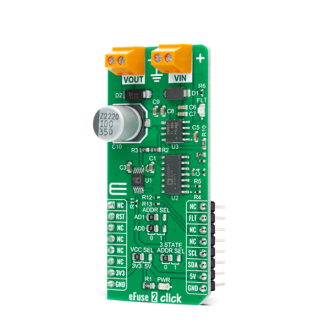
We strongly encourage users to use Package manager for sharing their code on Libstock website, because it boosts your efficiency and leaves the end user with no room for error. [more info]

Rating:
Author: MIKROE
Last Updated: 2021-01-29
Package Version: 1.0.0.0
mikroSDK Library: 1.0.0.0
Category: Power Switch
Downloaded: 2845 times
Not followed.
License: MIT license
eFuse 2 Click is a compact add-on board that contains an integrated FET hot-swap device. This board features the TPS259631, a highly integrated circuit protection and power management solution from Texas Instruments.
Do you want to subscribe in order to receive notifications regarding "eFuse 2 click" changes.
Do you want to unsubscribe in order to stop receiving notifications regarding "eFuse 2 click" changes.
Do you want to report abuse regarding "eFuse 2 click".


Library Description
The library covers all the necessary functions to control eFuse 2 Click board™. Library performs a standard I2C interface communication.
Key functions:
float *min_voltage, float *max_voltage ) - Set operating voltage function.void efuse2_set_operating_current ( float current ) - Set operating current function.void efuse2_operating_mode ( uint8_t mode ) - Set operating mode function.Examples description
The application is composed of three sections :
void application_task ( )
{
if ( efuse2_get_fault( ) == EFUSE2_FAULT )
{
efuse2_operating_mode( EFUSE2_AD5175_SHUTDOWN_MODE );
Delay_ms( 1000 );
mikrobus_logWrite( " Shutdown Mode ", _LOG_LINE );
mikrobus_logWrite( "-----------------------------", _LOG_LINE );
for ( ; ; );
}
FloatToStr( op_voltage, log_text );
mikrobus_logWrite( " Oper. Voltage : ", _LOG_TEXT );
mikrobus_logWrite( log_text, _LOG_TEXT );
mikrobus_logWrite( " V", _LOG_LINE );
FloatToStr( min_voltage, log_text );
mikrobus_logWrite( " Undervoltage : ", _LOG_TEXT );
mikrobus_logWrite( log_text, _LOG_TEXT );
mikrobus_logWrite( " V", _LOG_LINE );
FloatToStr( max_voltage, log_text );
mikrobus_logWrite( " Overvoltage : ", _LOG_TEXT );
mikrobus_logWrite( log_text, _LOG_TEXT );
mikrobus_logWrite( " V", _LOG_LINE );
FloatToStr( op_current, log_text );
mikrobus_logWrite( " Current Limit : ", _LOG_TEXT );
mikrobus_logWrite( log_text, _LOG_TEXT );
mikrobus_logWrite( " A", _LOG_LINE );
mikrobus_logWrite( "-----------------------------", _LOG_LINE );
Delay_ms( 2000 );
}
Other mikroE Libraries used in the example:
Additional notes and informations
Depending on the development board you are using, you may need USB UART click, USB UART 2 click or RS232 click to connect to your PC, for development systems with no UART to USB interface available on the board. The terminal available in all MikroElektronika compilers, or any other terminal application of your choice, can be used to read the message.